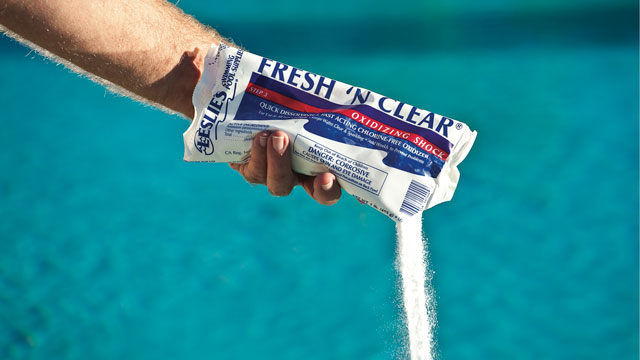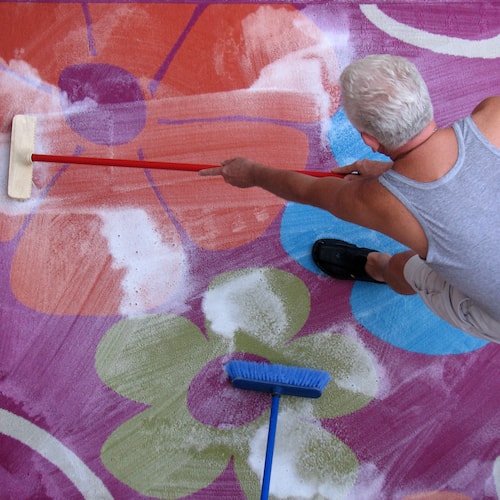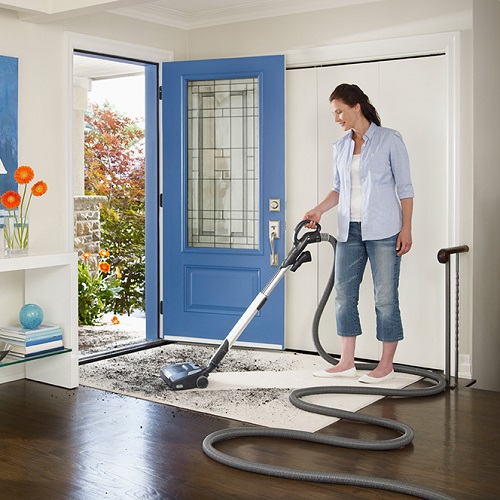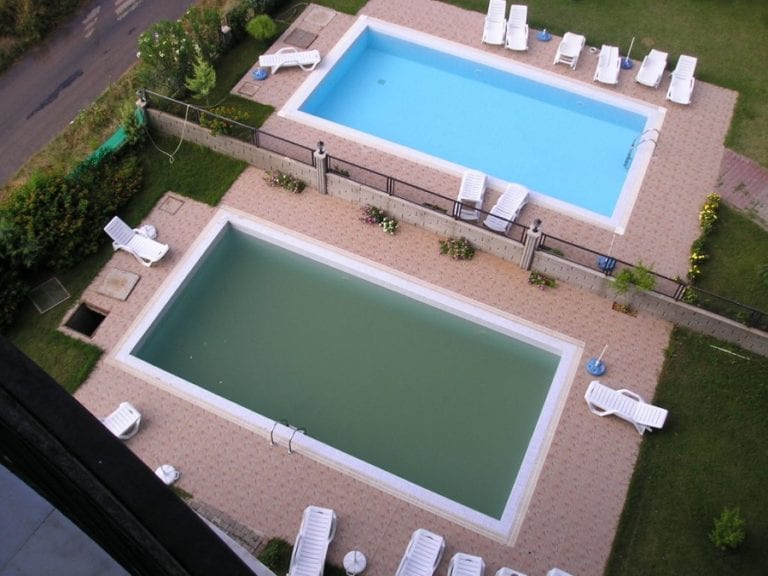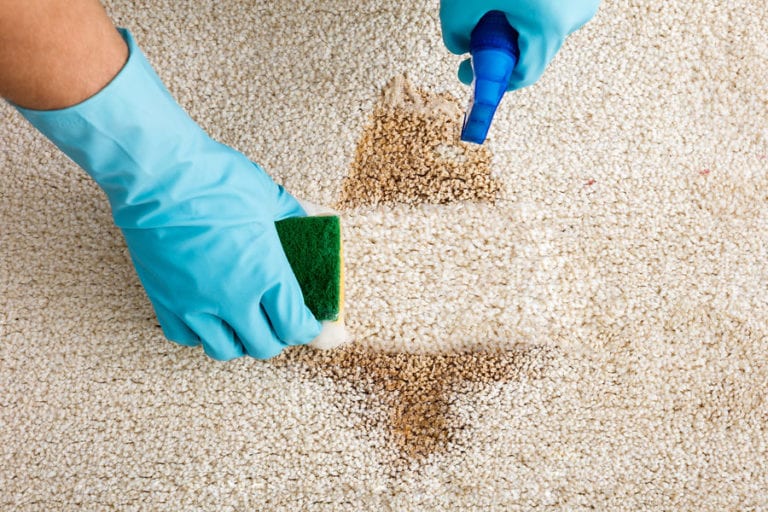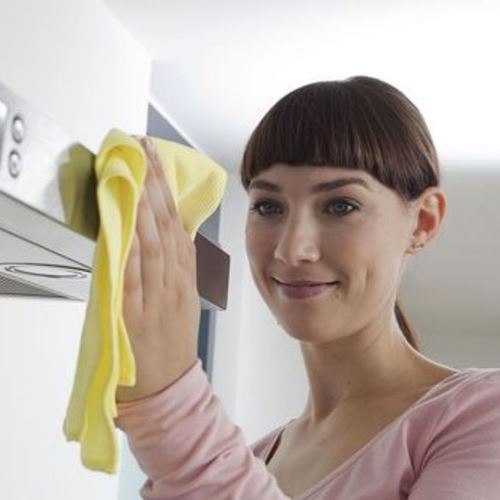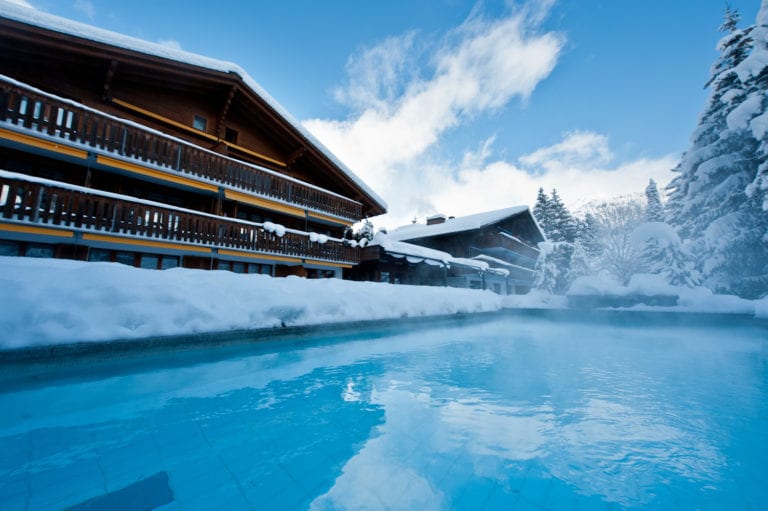How to Shock A Pool | A Step By Step Rundown & Troubleshooting Tips
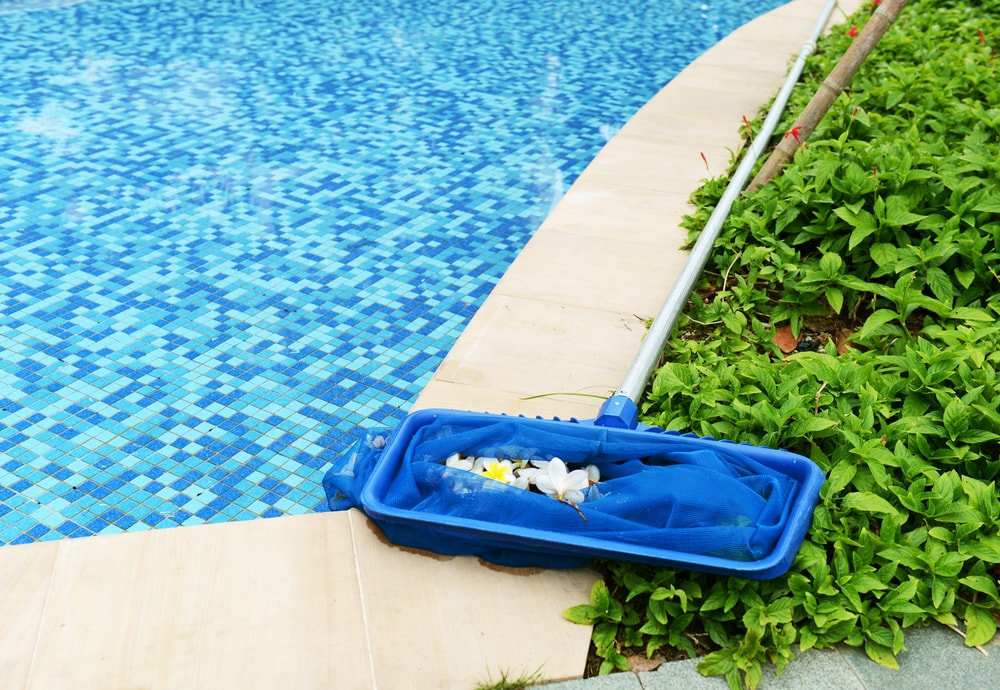 When you decide you want a pool in your backyard, and you have one installed, you also need to know how to shock a pool. That way, it is always safe to swim in. If you winterized your pool and warm weather is moving in, plan to clean and shock your pool about a week before you take your first swim.
When you decide you want a pool in your backyard, and you have one installed, you also need to know how to shock a pool. That way, it is always safe to swim in. If you winterized your pool and warm weather is moving in, plan to clean and shock your pool about a week before you take your first swim.
So, what does it mean to shock your pool? It means you clean the pool by adding an excess of chlorine to the pool water, so it will kill off any contaminants and bacteria that could make you ill.
In the process, you are sanitizing the pool and making it safe for everyone to swim in. Test the pool water daily, especially if the neighborhood kids come over to swim in your pool all the time. When the ingredient levels begin to slightly change, you need to add the shock treatment.
How to Shock a Pool, Begin With A Pool Water Tester
Purchase a water tester so you have one handy to test your pool water often. This is important so that algae and other unwanted ingredients do not begin growing unnoticed in your pool in its early stage.
Your water, as a visual indicator of negative change, becomes cloudy and turns green. That is when you know you need to shock the pool. But, do not wait that long until your water turns, as unpleasant things are already growing in the pool.
What Levels to Test For
The three main water ingredients you will constantly check levels for are: free chlorine, alkalinity, and the pH level, which is a measure of hydrogen ion. This is especially important whenever the water becomes warmer during the hot summer days, or if it is warm spa water. Warm water must be shocked more often. Test the water first before conducting the first shock treatment.
pH Level
pH level stands for how acidic the water is, and the range is from 0 to 14, with 7 as a neutral level. Less than 7 shows the water as acidic, while a level greater than 7 shows it is more alkaline. Clear bottled drinking water averages around a pH range of 6.5 to 8.5, in case you wanted to know. For your pool water, the pH level should range between 7.2 and 7.6.
Alkaline Level
Your water’s alkaline level should range between 80 and 120 parts per million (ppm). If your pool water is almost totally alkaline, add muriatic acid at once, based on your pool water volume. Let the water sit until the alkaline level has reached the proper level given above before you begin the shock treatment. See more information about this next.
Free Chlorine (FC) Level
The short version of what you should know in measuring chlorine is that free chlorine (FC) is the amount of available chlorine still available in the pool to sanitize the water properly.
There is also combined chlorine (CC) which is compromised chlorine because it has interacted with bacteria, sweat, suntan lotion residue, sunlight, and other foreign compounds to create chloramines. Free chlorine, when it bonds with the nitrogen or ammonia output of foreign compounds, turns into CC. CC is now unable to disinfect anything. When you shock pool water, all CC is eliminated because the added chlorine takes it over and “burns” it up.
Combining FC and CC leads to the total chlorine (TC) level count, which should be equal or greater than that important FC level reading.
If you ever smell “too much” chlorine (which is the CC that smells), this means you must add more chlorine because there is not enough available in the water to properly disinfect it. FC is working extra hard to try and clean things up.
Related: Best Solar Pool Heater
Another thing to know is that when the pH balance is too high (alkaline), this also threatens the available FC’s ability to clean the pool water effectively. Start the stabilization with muriatic acid to get the water back to proper pH levels.
Find out more at this link about chlorine and how it relates to cyanuric acid (CYA) and the pH level.
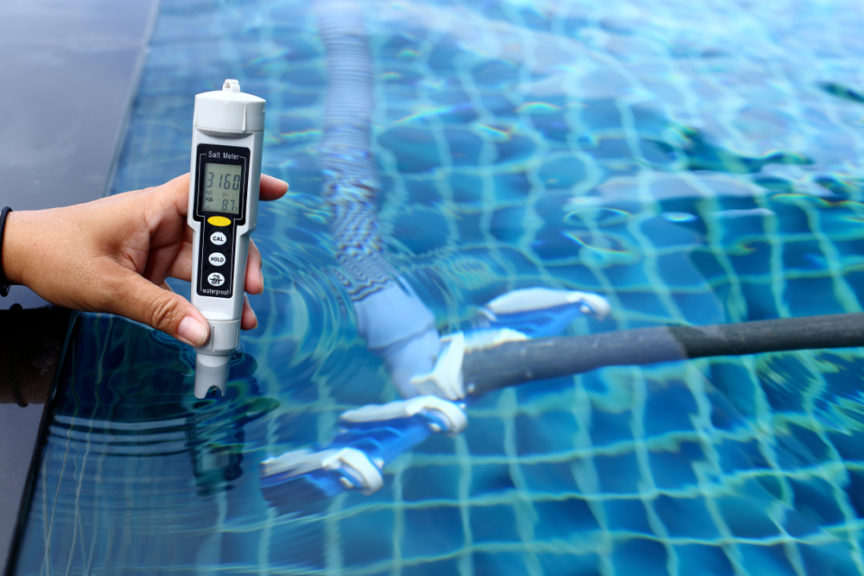 Preparing Your Pool for a Shock Treatment
Preparing Your Pool for a Shock Treatment
The first time that you want to shock your pool after winter is over, remove all pool covers and remove any debris in the pool, such as leaves. If there is a low level of water in the pool, then add water to the pool, up to the normal swimming level.
Do not use the pool cover again as you need the water to be the same temperature as it is outside. If the pool is inside the water should be room temperature.
Never run your heating pump at the same that you shock a pool. Avoid shocking warmed water, such as what you get when the sun shines directly on it throughout the day. Take the temperature of the water, starting a few days before the shock, to see what the average pool water temperature is in the evening hours.
1. Calculate Your Pool Size for Water Volume
By now, you should also know the volume of water that fits in your pool, as you will add the right amount of shock based on that measurement. Here is one way to get the numbers calculated. Once you have the numbers, you will know how much chlorine to shock pool with.
Measure the length of your pool by its width. If it is a surface pool, then you can measure from the ground to the top level of water inside the pool as its depth. Measure from the bottom to the top of the pool rim, then stick the measuring tape down inside to the water level. Subtract those numbers from the total of the bottom to top of the pool.
Now you can plug those numbers into the formula calculation as Length times Width times Depth times 7.5 (gallons in each foot) = Volume (or L x W x D x 7.5 = V).
If you want to know more about getting your correct pool’s water volume, go here to this handy online pool water calculator. You can even calculate uneven depths in a customized pool, as well as for round pools.
2. Test for pH and Free Chlorine Content Levels
Test your pool water for readings of your pH, alkaline, and free chlorine levels. You must look for whether your water is too alkaline, in which case you add muriatic acid first before doing the shock treatment.
If you do have to add muriatic acid, add the amount shown on the package that stands for your pool water volume (gallons). For example, add a quart of muriatic acid for 15,000 gallons.
Get a portable bucket of water and gently pour the acid into the water to dissolve it. Use protective gear when doing so. Start the pool pump, add the acid into the pool, and run the pump for an hour. Test the water for current readings. Keep running the pump until the pH balance is restored. You can find out more about muriatic acid here.
You are ready to apply the shock treatment when pH is back to a reasonable balance (between 7.2 and 7.6). If all you need to do is add muriatic acid and you want to go swimming, make sure the pump is running and wait three to four hours after dispensing the acid before getting into the pool. Test the pool water first to make sure the pH balance is correct. Only get in the water if it is crystal clear.
Related: Best Pool Pump
Help—Pool Cloudy After Shock!
Cloudy pool water after shocking can happen for several reasons. If the pool water is cloudy after both the muriatic treatment and shock treatment, then test the water again for reference. You may need to add muriatic acid again and do another shock after that. However, do the following step first.
Check your pool pump and filter to make sure it is clear of debris and in good shape before you do another round with muriatic acid and the shock treatment. Your problem could also be a malfunction in your pump system, especially if it is an older system.
3. Chlorine or Non-Chlorine Shock
Many pool owners use a chlorine shock, but if you are sensitive or allergic to chlorine, choose a non-chlorine shock product for this next section. You buy the amount of chlorine shock treatment, usually one bag (or one pound) per 10,000 gallons of water (volume) in a pool. Note that if you have significant algae in the pool water, you may need to add twice or three times the amount of chlorine to get rid of it. You select how much chlorine to add to shock pool, based on your water test readings.
You can read the instructions on the product to know how much you should buy, based on your pool’s water volume. Buy extra, just in case you have a more severe problem. Store unused shock in a cool, dark protected area, preferably in a closed plastic tub to keep it dry.
Non-chlorinated shock treatment options, aside from chlorine sensitivities, can be a better choice if you have hard water problems, or use vinyl pool liners. Also, they do not leave any ‘pool cloudy after shock’ effect.
One of the highlights of non-chlorinated shock treatments is that you can get into the water sooner than if you use a chlorine shock treatment, for which you may need to wait 48 hours. Using a non-chlorine shock treatment means you can get in almost right after treatment.
You should always check the labels to be sure about the right time to get in for each of these products. Never forget to take your readings to make doubly sure that it is safe.
Check this link, non-chlorine products, which may be helpful to you, if you are sensitive to chlorine.
4. Apply the Shock Treatment
When you get ready to pour the shock, add water in a plastic hand-carry bucket first, and then gently pour the shock into it to pre-dissolve it. It is better to have the shock in a liquified state, so it disperses easily. This is particularly important if you have a plastic liner in your pool. If in granular form, it may settle to the bottom, and chew up the plastic.
You may need to wear protective gear, such as a face mask to protect your eyes, nose, and mouth from getting any fumes into sensitive membranes, while you pour the shock into the water. Also, wear plastic dishwashing gloves or workers gloves to protect your hands while mixing, and for carrying the bucket while dispensing the shock.
Walk around the pool edge as you pour the shock into the pool. Next, turn on your pool pump (not your heating pump) and let it run for at least seven hours, and up to 24 hours if necessary.
Some posts have said that running the pump will cost you in electricity expenses. However, running the pump, despite its costs, does a better job of dispensing the shock throughout the volume of water. It is either that or spend money hiring a professional to handle the job. Generally, you should run the pump daily anyway, for up to seven or eight hours.
Never shock a pool while it is raining or threatening to rain. The accumulation of more water, plus debris, can change the water volume and you may need to reduce the water to proper swimming levels before testing the water. Clean the pool too and test the water.
Related: Best Above Ground Pool
When Is It Time to Apply a Shock Application?
Unused Pools
The answer to this question is deciding first how dirty your pool is. If the pool has been sitting unused for over two years and you are not experienced with shocking a pool in this state, call in a professional and have them take care of it. It will be worth the aggravation for them to do it, instead of you.
At the same time, you can watch and learn a lot from the service professional about what it takes for a good cleanup. You may also be moving a few frogs and other wildlife that have settled in their happy haven. A pool in this state, may need to go through several treatments that can take a few weeks, depending on the situation.
Note: If your pool is left standing unused for a long time, consider adding a perimeter fence and an entrance gate, with a lock, around the pool. This gives a safety element that will keep children and pets (including neighbors’ children) from going into the pool area. Install caution signs on the gate.
It also helps for the same reason, that when you are shocking a pool, or adding other chemicals, that children and pets do not play around the pool while chemicals are at work. You never know when one of them could fall in, especially if they are alone.
If the pool water is cloudy and murky, for example, you would never know until too late that anything had happened if a child or pet did fall in. Practice pool safety to those who use the pool regularly. Always keep a secured pool cover on top when the pool will not be in use. You can never be too paranoid about your loved ones’ safety.
New Swimming Season
If you have simply over-wintered your pool from the earlier swimming season, then it may take only one shock treatment. Test the water first to get those measurement readings for the status of the water’s pH and FC levels.
Check the readings to see if you need to apply muriatic acid (or hydrochloric acid) first because of a high alkaline reading. This would be if the pH reading is above 7.8. If it is above that number, then you must add the acid first before doing the shock. It is useless to do the shock until then.
How Long to Wait After the Shock Application?
Once you apply the shock treatment to the pool water and are running the pump, wait seven to eight hours, then test the pool water. Remember to apply the shock in the early evening hours when there is still light to see by, but not while direct sunlight shines on the water.
You want to avoid any sort of heating while the pool water is stabilizing. Remember never to run any heat pumps either. Only run the pool pump.
While you can wait eight hours before going in the pool, waiting 24 to 48 hours would be better. Run the pump the whole time to ensure that all the water has had time to run completely through the filtration system. This process also helps sanitize the filtration and pump system too. Always test that water before going in. The chlorine level should be less than 5 ppm.
If you use a non-chlorinated shock treatment, it is possible to get in the pool right after the treatment. Check your product’s instructions to know exactly when to get into the pool. Always do your water tests first.
It is preferable, however, to at least let the water completely run through the pump once, just to be sure. If you live to swim in your pool as often as you can, you may feel like your water testing kit is your new best friend because you must interact with it often.
Related: Best Inflatable Pool
Using Other Applications to Support Your Pool
There are other chemicals you can add, such as calcium chloride, after which you should wait two to four hours before getting into the pool. The level should read 5 ppm (pounds per million), or, to be safe, wait 24 hours which is a full filter system cycle. Always follow the directions on your chemical package and instructions.
Troubleshooting Tips and Things to Know
How Often Should You Shock Your Pool?
The typical time span for shocking your pool during average use would be once a week. If you have children from the neighborhood coming over every day to swim in your pool with your own children, you may need to do it more often during the week.
Do a daily test with your kit to make sure you know what the readings are every day. If you use your heat pump during cooler weather, you should test your water too, as heat from the sun and heating pumps will change the water and make it more susceptible to algae growth.
If you have storms passing through your area, get a pool cover to protect your water. Leaves and other debris from the surrounding environment will get blown into your pool, and the chlorine will begin working harder to get rid of it, which means the chlorine depletes faster into CM mode.
Add the cover, preferably before the storms get too heavy, then when the storm is over with, test the water to make sure it is safe.
If I Cannot Do It Myself, How Do I Choose a Service Professional?
By now, you realize that there is a lot more to owning and supporting a pool and its water in a safe manner so that everyone can enjoy it. That is why there is a whole industry with service professionals who are there to take over when things get too complicated for you to handle.
Always choose a service provider that comes with good credentials and has high online ratings from its customers. The power of a good review goes a long way for everyone concerned.
What Kind of Pool Water Testing Kit Should I Buy?
Choose a kit that offers you many testing results such as pH, alkalinity, free chlorine, combined/total chlorine, calcium hardness, cyanuric acid, and more. Make sure you understand what each of the components stand for, aside from pH, alkalinity, FC, CC, and TC.
Some kits come with a photometer giving a digital reading, but you may need to use tablets to test for cyanuric acid. Check to see how long any tablets and chemicals associated with the testing kit will last. Some testing ingredients (powders, tablets) may last over a year, while others are under a year. Ideally, the kit comes in a protective case, such as a polyethylene case, for easy storage in a safe cool place.
Select a kit that gives complete instructions on how to use it and what each test means at the varying numerical levels. When a kit says reagent, this refers to the testing solution(s) (powder, liquids, tablets) used to test the water.
Some tests use colored tabs to show the level of pH, alkalinity, and other components you want to look at. You can go to this link to find out what some of the 2018 top kits are to look at. Links from the products take you to Amazon for review of each kit. Always note the rating for each kit you look at and read customer reviews, as they are the best indicator of how well the kit works.
Some of these kits may be expensive but weigh what the kit offers you in terms of how many results you can get out of it, along with ease of usage. A digital reading makes it easier than trying to match color-coded tabs, but you still may need to do chemical tablet testing too.
You can visit this link for YouTube videos that show how to use various pool water testing kits. Apparently, there is also an app that goes with one or two kits too. Technology expands exponentially, as always. With that in mind, let us look at what apps are available.
Related: Best Pool Heater
Using Smartphone Apps
Life could not get any easier! The smartphone app Insta-LINK Home will read test strips and tell you what you need to add to your pool water. You can get the app on Google Play.
Check first on Amazon to have a look at this product. Always check out reviews that will help you understand more about how the product works.
If you have a Zodiac iAquaLink system installed in your pool, then you may already know about the app that runs everything connected to your pool. That includes pumps, lights, and temperature. Yep, all of those things can be easily managed right from your phone. You can find this app on Google Play too.
I Have Cloudy Pool Water After Shocking
- Step one: Note how long the pump has been running. Check the pump system for damage.
- Step two: Check the filtration system to see if you need to clear out debris. Run the pump again.
- Step three: Do a water test to see if you need to add muriatic acid to raise it to the right pH level again. If so, wait until the water reaches the proper levels and do the shock again.
Safety is paramount when it comes to the well-being and health of your family members and those who visit you and swim in your pool. Never get into the pool until you have normal water readings and the pool is crystal clear. Now, enjoy your sparkling clean pool.
